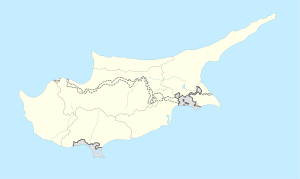Balalan, Cyprus
Balalan | |
|---|---|
village | |
| Πλατανισσός (Greek) | |
| Coordinates: 35°28′41″N 34°6′23″E / 35.47806°N 34.10639°E / 35.47806; 34.10639 | |
| Country (de jure) | |
| • District | Famagusta District |
| Country (de facto) | |
| • District | İskele District |
| Government | |
| • Mukhtar | Cafer Özbalalanlı |
| Population (2011)[2] | |
| • Total | 89 |
| Time zone | UTC+2 (EET) |
| • Summer (DST) | UTC+3 (EEST) |
Balalan or Platanissos (Greek: Πλατανισσός) is a village in the Famagusta District of Cyprus, located on the Karpas Peninsula. It is under the de facto control of Northern Cyprus.
History
Since the Ottoman period the village has been almost exclusively inhabited by Turkish Cypriots, with the exception of a handful of Greek Cypriots recorded in some censuses until 1931. The village's population showed a steady increase through the 19th and early 20th centuries. 74 adult males were recorded in the Ottoman census of 1831, and the full population of the village peaked in 1946 at 445. A decline followed with villagers either migrating to cities or abroad due to the conflict that took hold of Cyprus from the 1950s onwards.[3]
From the Bloody Christmas events of 1964 until 1974, the village was part of a Turkish Cypriot enclave remaining under the effective control of the Turkish Resistance Organisation. It was administered from the regional centre of Galateia and was home to some Turkish Cypriots who had fled the neighbouring villages due to the fighting.[3] During the conflict in 1974, as Turkish forces landed near Kyrenia, the village came under attack by the Greek Cypriot National Guard, who sought to take control of the enclaves. By the evening of 21 July, the regional command in Galateia reported that Balalan was about to fall. It reportedly fell on the evening of 22 July, with the villagers seeking refuge in Galateia.[4]
The decline of the village continued after the conflict in 1974 as well, with the youth leaving the village for job opportunities.[3]
Historically, a defining feature of the village was the high number of lawyers and judges that came from there. The most notable of these was Mehmet Zekâ Bey, who headed the Supreme Court of Cyprus during the last years of the British rule, and ended up being elected as a judge for the European Court of Human Rights in 1961. His renown was so outsize compared to his village that at this point Balalan became known as "Horgon du Zekâ Bey", meaning "the village of Zekâ Bey" in common parlance.[5]
Architecture
Mosque
The current mosque building was built in 1904 on the site of a much older Ottoman-era mosque. The marble inscription of the older mosque is still attached at the entrance, indicating a possible construction date of 1641 for the former building. In 1904, the villagers demanded funds from the Evkaf Administration to build a new mosque, as the older one was falling apart. When no funds were received, they raised money to build the mosque, enlisting a Greek Cypriot mason called Hacı Yorgi. This was then insufficient to complete the roofing of the mosque, and further funds were requested from the Evkaf Administration in 1907, to no response. Funding was later located, there were records as late as 1910 that indicate requests for help to complete the roofing. There were further repairs of the mosque conducted in 1954 and 1974.[6]
It displays a typical Cypriot mosque layout with a rectangular plan, but is notable in that its entrance is from the east, whereas this is normally located in the north in Cyprus. This entrance door is located within a round arch. Four sharp arches carry the roof, and among them are bays, the presence of which indicate some inspiration from Orthodox churches. The minaret on the northeastern side is a later addition, having only been built in 1997-1998.[6]
A traditional primary school (sıbyan mektebi) had been attached to the mosque in the early 20th century.[6]
References
- ^ In 1983, the Turkish Republic of Northern Cyprus unilaterally declared independence from the Republic of Cyprus. The de facto state is not recognised by any UN state except Turkey.
- ^ KKTC 2011 Nüfus ve Konut Sayımı [Northern Cyprus 2011 Population and Housing Census] (PDF), Northern Cyprus State Planning Organization, 6 August 2013, archived from the original (PDF) on 6 November 2013, retrieved 26 September 2014
- ^ a b c "Platanissos". PRIO Cyprus Centre, Routes of Displacement Project. Retrieved 17 July 2023.
- ^ Sadrazam, Halil (2013). Kıbrıs'ın Savaş Tarihi III: Birinci Harekât, Temmuz 1974 (in Turkish). Nicosia: Söylem Yayınları. p. 1514. ISBN 9789963747764.
- ^ Bağışkan, Tuncer (13 July 2014). "Bladanisyo / Balalan köyünün tarihi geçmişi HORGON DU ZEKÂ BEY Kaynak: Bladanisyo / Balalan köyünün tarihi geçmişi HORGON DU ZEKÂ BEY". Yenidüzen. Retrieved 23 August 2023.
- ^ a b c Bağışkan, Tuncer (2019). Kıbrıs'ta Türk, İslam ve İslamlaştırılan Eserler. Nicosia: Kıbrıs Türk Eğitim Vakfı Yayınları. pp. 285–287.


